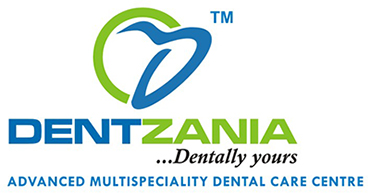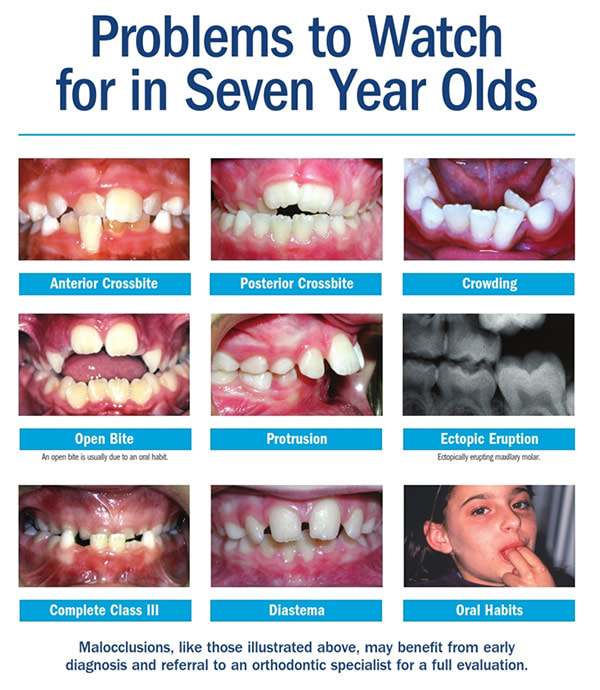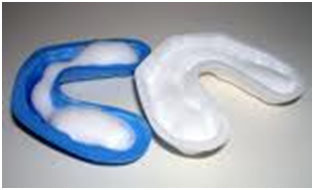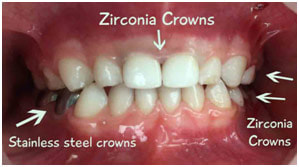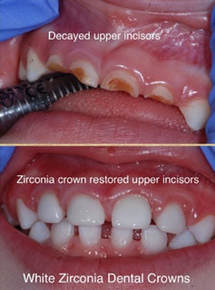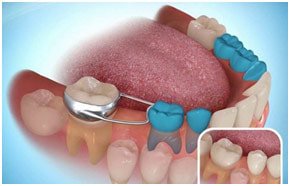KIDS DENTISTRY (PEDIATRIC DENTISTRY)
|
Pediatric Dentistry is a dental specialty that concentrates its attention on infants and children providing preventive and therapeutic oral health care. When it comes to the health of your child's primary teeth, there is no better time than now to start practicing excellent oral hygiene. Pediatric dental care ensures your child's primary teeth stay healthy and free of decay and other dental diseases.. While most babies don't start getting teeth until they are 6 months old, infant dental care is important from the very beginning. A dental visit is recommended before the child's first birthday to make sure teeth and gums are cared for and cleaned properly.
Few parents often feel “why spend on the maintenance of milk teeth when they are to be finally replaced by the permanent ones?” |
MILK TEETH ARE VERY IMPORTANT FOR YOUR KIDS WELLBEING AND HEALTH …
THE MAJOR FUNCTIONS OF MILK TEETH ARE DESCRIBED BELOW:
Speech production and development – Learning to speak clearly is crucial for cognitive, social, and emotional development. The proper positioning of primary( milk ) teeth facilitates correct syllable pronunciation and prevents the tongue from straying during speech formation.
Eating and nutrition – Children with malformed or severely decayed primary teeth are more likely to experience dietary deficiencies, malnourishment, and to be underweight. Proper chewing motions are acquired over time and with extensive practice. Healthy primary teeth promote good chewing habits and facilitate nutritious eating.
Self-confidence – Even very young children can be quick to point out ugly teeth and crooked smiles. Taking good care of primary teeth can make social interactions more pleasant, reduce the risk of bad breath, and promote confident smiles and positive social interactions.
Straighter smiles – One of the major functions of primary teeth is to hold an appropriate amount of space for developing adult teeth. In addition, these spacers facilitate the proper alignment of adult teeth and also promote jaw development. Left untreated, missing primary teeth cause the remaining teeth to “shift” and fill spaces improperly. For this reason, pediatric dentists often recommend space-maintaining devices.
Excellent oral health – Badly decayed primary teeth can promote the onset of childhood periodontal disease. As a result of this condition, oral bacteria invade and erode gums, ligaments, and eventually bone. If left untreated, primary teeth can drop out completely – causing health and spacing problems for emerging permanent teeth. To avoid periodontal disease, children should practice an adult-guided oral care routine each day, and infant gums should be rubbed gently with a clean, damp cloth after meals.
Eating and nutrition – Children with malformed or severely decayed primary teeth are more likely to experience dietary deficiencies, malnourishment, and to be underweight. Proper chewing motions are acquired over time and with extensive practice. Healthy primary teeth promote good chewing habits and facilitate nutritious eating.
Self-confidence – Even very young children can be quick to point out ugly teeth and crooked smiles. Taking good care of primary teeth can make social interactions more pleasant, reduce the risk of bad breath, and promote confident smiles and positive social interactions.
Straighter smiles – One of the major functions of primary teeth is to hold an appropriate amount of space for developing adult teeth. In addition, these spacers facilitate the proper alignment of adult teeth and also promote jaw development. Left untreated, missing primary teeth cause the remaining teeth to “shift” and fill spaces improperly. For this reason, pediatric dentists often recommend space-maintaining devices.
Excellent oral health – Badly decayed primary teeth can promote the onset of childhood periodontal disease. As a result of this condition, oral bacteria invade and erode gums, ligaments, and eventually bone. If left untreated, primary teeth can drop out completely – causing health and spacing problems for emerging permanent teeth. To avoid periodontal disease, children should practice an adult-guided oral care routine each day, and infant gums should be rubbed gently with a clean, damp cloth after meals.
BABY BOTTLE TOOTH DECAY (NURSING BOTTLE CARIES):
|
The term describes a dental condition which involves the rapid decay of many or all the baby teeth of an infant or child. The teeth most likely to be damaged are the upper front teeth since they are the first teeth to erupt and thus have the longest exposure time to the sugars in the feeding bottle. The lower front teeth tend to be protected by the tongue as the child sucks on the nipple of the bottle or the breast.
Baby Bottle Tooth Decay is caused by long exposure of a child’s teeth to liquid containing sugars generally when the baby falls asleep with a bottle containing milk or juice or a pacifier dipped in honey. The liquid pools around the front teeth. During sleep, the bacteria living in every baby’s mouth, turns the milk sugar or other sugars to acid which causes the decay. |
Although baby bottle tooth decay typically happens in the upper front teeth, other teeth may also be affected.
If teeth are infected or lost too early due to baby bottle tooth decay, your child may develop poor eating habits, speech problems, crooked teeth, and damaged adult teeth. In addition, the chances that adult teeth will end up being crooked are greatly increased.
If teeth are infected or lost too early due to baby bottle tooth decay, your child may develop poor eating habits, speech problems, crooked teeth, and damaged adult teeth. In addition, the chances that adult teeth will end up being crooked are greatly increased.
The good news is that a few simple steps can help stave off baby bottle tooth decay. They include implementing good oral hygiene at an early age. Here's how:
- Wipe the baby's gums with a clean gauze pad or washcloth after each feeding.
- Begin brushing your child's teeth, without toothpaste, when his or her first tooth comes in. If you choose to use toothpaste, use a fluoride-free one.
- Clean and massage gums in areas without teeth.
- Floss once all the baby teeth have come in.
- Make sure your child is getting enough fluoride, which helps lessen cavities. If your local water supply does not contain fluoride, ask your dentist or doctor if you need to use a supplement.
- Schedule regular dental visits by your child's first birthday. Dentists also offer special sealant coatings, which can help prevent tooth decay in children.
HERE AT DENTZANIA our goal is to help you and your child establish good dental habits and reduce the risk of cavities early on.
PREVENTIVE DENTISTRY FOR CHILDREN
1) EXAMINATION AND EDUCATION
Prevention begins with good dental habits, the right diet and regular visits to the dentist at a very early age. At DENTZANIA we cater to children of every age, and we love to educate parents and caretakers about good oral hygiene and nutrition because we want you to be able to make informed choices about your child’s dental health.
Your visit will start with a Caries Risk Assessment to see whether your child’s teeth have or are showing early signs of cavities. Our team will also provide you with oral hygiene instructions and guidance regarding diet, nutrition and other oral habits. The right nutrition and a simple fluoride treatment may be a sufficient alternative to a filling or restoration.
If this is the first time you’re visiting us, we’ll introduce you to the “knee-to-knee” exam method, which simply means your toddler will sit on your lap while we work.
These are the habit making or breaking years, where the teeth are developing and growing, so your child’s teeth need to be evaluated more closely. We’ll walk you through a Caries Risk Assessment to determine if your child has cavities, and we’ll provide you with oral hygiene instructions to address habits and prevent decay on the permanent teeth growing in.
Prevention begins with good dental habits, the right diet and regular visits to the dentist at a very early age. At DENTZANIA we cater to children of every age, and we love to educate parents and caretakers about good oral hygiene and nutrition because we want you to be able to make informed choices about your child’s dental health.
Your visit will start with a Caries Risk Assessment to see whether your child’s teeth have or are showing early signs of cavities. Our team will also provide you with oral hygiene instructions and guidance regarding diet, nutrition and other oral habits. The right nutrition and a simple fluoride treatment may be a sufficient alternative to a filling or restoration.
If this is the first time you’re visiting us, we’ll introduce you to the “knee-to-knee” exam method, which simply means your toddler will sit on your lap while we work.
These are the habit making or breaking years, where the teeth are developing and growing, so your child’s teeth need to be evaluated more closely. We’ll walk you through a Caries Risk Assessment to determine if your child has cavities, and we’ll provide you with oral hygiene instructions to address habits and prevent decay on the permanent teeth growing in.
2) PIT AND FISSURE SEALANTS
Sealants, also referred to as dental sealants, consist of a plastic material that is placed on the chewing (occlusal) surface of the permanent back teeth — the molars and premolars — to help protect them from bacteria and acids that contribute to tooth decay.
Why SEALANTS?
Thorough brushing and flossing helps remove food particles and plaque from the smooth surfaces of teeth, but toothbrushes can't reach all the way into the depressions and grooves to extract all food and plaque. While fluoride helps prevent decay and helps protect all the surfaces of the teeth, dental sealants add extra protection for the grooved and pitted areas.
Why Your Child Might Need Sealants
Even though pits and fissures do occur naturally, they can deepen over time, leading to dental caries, so a child whose teeth show signs of pits and fissures may be a prime candidate for dental sealants. Pits are small hollows that occur on the biting surfaces of permanent teeth, as described by the International Dental Health Foundation, whereas fissures are grooves in the outside of the tooth's surface. In both cases, these areas can easily fill with bacteria, which may be difficult to remove with regular oral hygiene.
Sealants, also referred to as dental sealants, consist of a plastic material that is placed on the chewing (occlusal) surface of the permanent back teeth — the molars and premolars — to help protect them from bacteria and acids that contribute to tooth decay.
Why SEALANTS?
Thorough brushing and flossing helps remove food particles and plaque from the smooth surfaces of teeth, but toothbrushes can't reach all the way into the depressions and grooves to extract all food and plaque. While fluoride helps prevent decay and helps protect all the surfaces of the teeth, dental sealants add extra protection for the grooved and pitted areas.
Why Your Child Might Need Sealants
Even though pits and fissures do occur naturally, they can deepen over time, leading to dental caries, so a child whose teeth show signs of pits and fissures may be a prime candidate for dental sealants. Pits are small hollows that occur on the biting surfaces of permanent teeth, as described by the International Dental Health Foundation, whereas fissures are grooves in the outside of the tooth's surface. In both cases, these areas can easily fill with bacteria, which may be difficult to remove with regular oral hygiene.
|
3) FLUORIDE APPLICATION
A child’s teeth are more prone to decay due to lack of proper dexterity of brushing. Application of fluoride varnishes at regular intervals strengthens the tooth structure by incorporating fluoride ions into the structure making them more prone to acid dissolution. Not only do the permanent but also milk teeth benefit from fluoride treatment. • The professional application of fluoride is particularly recommended because of the ease of application, patient acceptance and proven anti -decay benefits. For maximum benefits, reapplication should be made every 4 months. • Of the various home-use fluoride products (toothpastes, mouthwashes and gels) only fluoride toothpastes are recommended for young children, but caution must be exercised to minimize fluoride ingestion. |
TREATMENTS AND AFTER TREATMENT MODALITIES
1) TOOTH COLORED FILLINGS :
cases of early cavitations and discolorations due to decay are removed to prevent further spread and loss of tooth structure / pain and filled with a ctooth colored filling material like glass ionomer ( GIC ) or composite.
cases of early cavitations and discolorations due to decay are removed to prevent further spread and loss of tooth structure / pain and filled with a ctooth colored filling material like glass ionomer ( GIC ) or composite.
|
3) SPACE MAINTAINERS :
A space maintainer is a removable or fixed appliance designed to maintain an existing space. Space maintainers are usually fitted in children when they have lost baby teeth early. The gap left from losing this tooth needs to be held open for the permanent tooth to erupt in the correct position. |
